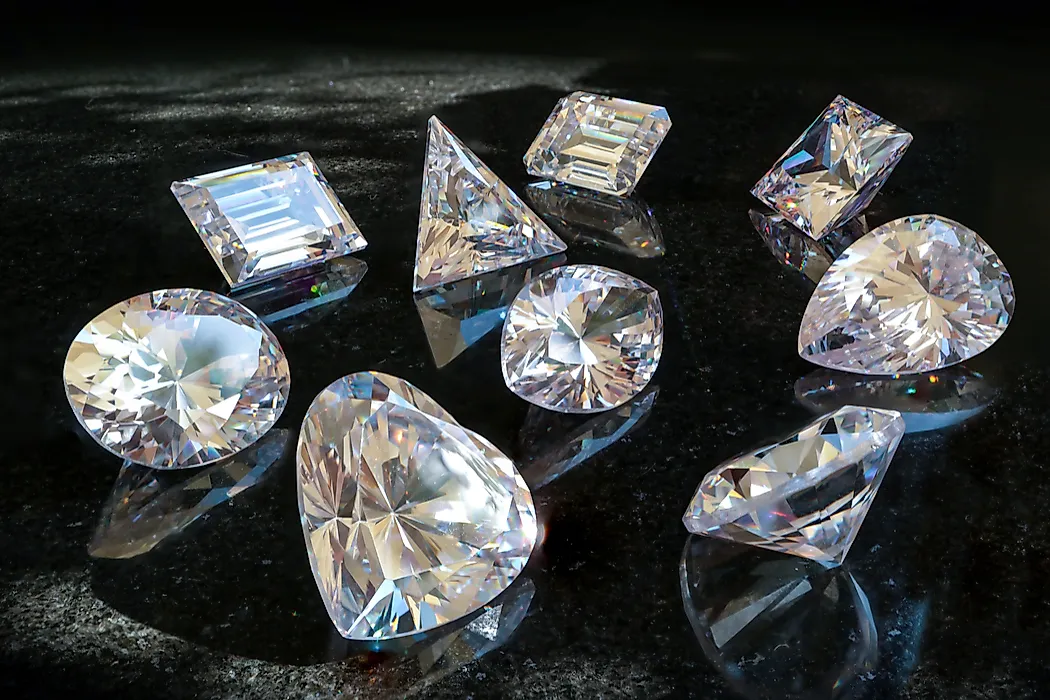What is Diamond?

5. Description
Diamonds have been a valuable commodity dating back as far as the 4th Century BC. Since their discovery and initial use as a luxury item in India long ago, some of today's largest Diamond deposits have been found in Brazil, across Asia, and in Southern African countries. Diamonds have a very glossy, shiny, appearance, which, along with their rarity, is a large part of why they’ve come to be so desirable. 99.95 percent of diamonds' chemical composition is elemental carbon, while the other 0.05 percent is comprised by a collection of other elements that aren’t necessarily a part of the diamond’s natural chemistry, and considered to be 'trace minerals' that may actually decrease a diamond's purity and value. Their isometric structures give diamonds their shape and sparkle. Such attributes also dictate how much a particular diamond may be sold for on the market. These isometric shapes form due to their constituent carbon atoms bonding together in the same way in all directions, which turn them into unique members of the mineral kingdom, despite the commonness of carbon itself.
4. Location
90% of the world's diamond supply is commercially extracted from within 50 of the world's largest mines. At times, diamonds can be found in different deposits around the world that have either been eroded out, or stuck in, water or rock due to weather activities. The largest diamond supplies can be found in such African countries as Botswana, Angola, and South Africa. Russia, India, and Indonesia also have large deposits of diamonds as well, although none of these are nearly as large as those being found in the south of the African Continent. Canada is also among the largest providers of diamonds worldwide.
3. Formation
A diamond will form in conditions of high temperatures and high pressures, at depths of between 140 and 190 kilometres inside of the Earth’s mantle. Mineral deposits within the Earth’s mantle source the precious jewel's carbon, which makes up around 99.5% of any given diamond. It will typically take between 1 and 3.3 billion years for these carbon compounds to finally form into the minerals we know and mine as diamonds. Diamonds are then brought from their deep depths of origin up towards the Earth's surface through volcanic activities, namely powerful magma flows.
2. Uses
Other then the obvious fashion statements that they help their owners makes, diamonds are very durable, resistant to heat, and virtually impossible to scratch through conventional means. That being said, diamonds are often used to cut through extremely hard surfaces in construction and mining, and they are also used in precision cutting, grinding, and polishing. For such purposes, very small pieces of diamond are embedded into the grinding wheels, saw blades, and drill bits for utilization for these various trades and jobs. In fact, Diamonds are among the only natural materials that will cut through certain kinds of glass and other hard stones used by humans.
1. Production
Due to their rarity, Diamonds continue to contribute a huge amount of GDP to the global economy, and their output in terms of mineral mass has increased substantially in modern times, following the first discoveries of large South African deposits in the second half of the Nineteenth Century. Today, Russia and Botswana combine to account for over 50% of global diamond production. Today, the world is producing an estimated 48,300,000 carats of diamonds collectively. Diamonds have been used to fuel wars and violent criminal activities in certain regions, giving rise to the term "blood diamonds". They especially carry such a notorious distinction in such African countries as Botswana, and for financing the infamous Sierra Leone Civil War. Although largest quantities of diamonds are produced elsewhere, it’s The United States that consumes the most diamonds of any single country alone. Americans spent $19 billion dollars for gemstone purchases in 2011 alone and, of those gemstones, $18 billion dollars' worth of that value was specifically spent on diamonds. This almost equals all of the production of Asia and Eastern Europe, wherein producers contribute $26.1 billion annually to the diamond industry collectively.











